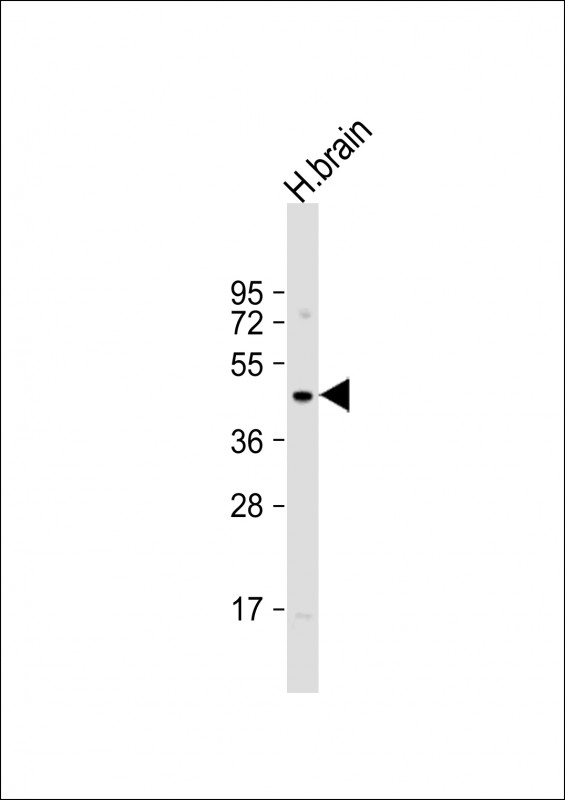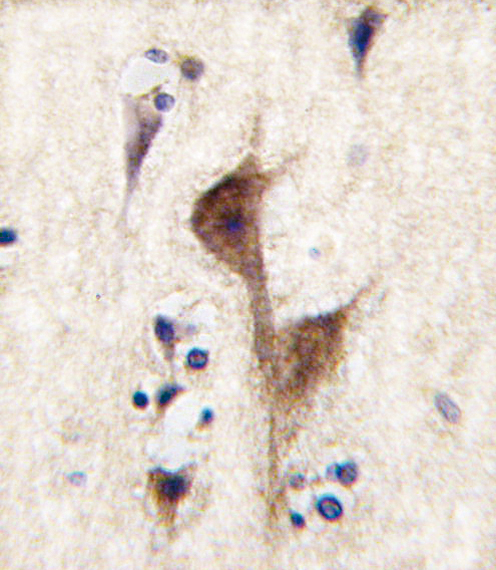HRH3 Antibody (C-term)
Purified Rabbit Polyclonal Antibody (Pab)
- SPECIFICATION
- CITATIONS
- PROTOCOLS
- BACKGROUND

Application
| IHC-P, WB, E |
|---|---|
| Primary Accession | Q9Y5N1 |
| Reactivity | Human |
| Host | Rabbit |
| Clonality | Polyclonal |
| Isotype | Rabbit IgG |
| Calculated MW | 48671 Da |
| Antigen Region | 414-442 aa |
| Gene ID | 11255 |
|---|---|
| Other Names | Histamine H3 receptor, H3R, HH3R, G-protein coupled receptor 97, HRH3, GPCR97 |
| Target/Specificity | This HRH3 antibody is generated from rabbits immunized with a KLH conjugated synthetic peptide between 414-442 amino acids from the C-terminal region of human HRH3. |
| Dilution | IHC-P~~1:10~50 WB~~1:1000 E~~Use at an assay dependent concentration. |
| Format | Purified polyclonal antibody supplied in PBS with 0.09% (W/V) sodium azide. This antibody is prepared by Saturated Ammonium Sulfate (SAS) precipitation followed by dialysis against PBS. |
| Storage | Maintain refrigerated at 2-8°C for up to 2 weeks. For long term storage store at -20°C in small aliquots to prevent freeze-thaw cycles. |
| Precautions | HRH3 Antibody (C-term) is for research use only and not for use in diagnostic or therapeutic procedures. |
| Name | HRH3 |
|---|---|
| Synonyms | GPCR97 |
| Function | The H3 subclass of histamine receptors could mediate the histamine signals in CNS and peripheral nervous system. Signals through the inhibition of adenylate cyclase and displays high constitutive activity (spontaneous activity in the absence of agonist). Agonist stimulation of isoform 3 neither modified adenylate cyclase activity nor induced intracellular calcium mobilization. |
| Cellular Location | Cell membrane; Multi-pass membrane protein. |
| Tissue Location | Expressed predominantly in the CNS, with the greatest expression in the thalamus and caudate nucleus. The various isoforms are mainly coexpressed in brain, but their relative expression level varies in a region-specific manner. Isoform 3 and isoform 7 are highly expressed in the thalamus, caudate nucleus and cerebellum while isoform 5 and isoform 6 show a poor expression. Isoform 5 and isoform 6 show a high expression in the amygdala, substantia nigra, cerebral cortex and hypothalamus. Isoform 7 is not found in hypothalamus or substantia nigra |

Thousands of laboratories across the world have published research that depended on the performance of antibodies from Abcepta to advance their research. Check out links to articles that cite our products in major peer-reviewed journals, organized by research category.
info@abcepta.com, and receive a free "I Love Antibodies" mug.
Provided below are standard protocols that you may find useful for product applications.
Background
The histamine receptor H3 (HRH3) is a presynaptic autoreceptor on histamine neurons in the brain and a presynaptic heteroreceptor in nonhistamine-containing neurons in both the central and peripheral nervous systems. The deduced 445-amino acid HRH3 protein contains 7 predicted transmembrane domains. HRH3 has significant sequence homology to members of the biogenic amine subfamily of GPCRs. Most notable is an aspartic acid residue in the predicted third transmembrane domain, which is a hallmark of the biogenic amine receptor subfamily; this residue is the putative binding site for the primary amine. HRH3 shares 22% and 21.4% amino acid sequence homology with the H1 and H2 receptors, respectively. Expression of recombinant HRH3 in a variety of cell lines conferred an ability to inhibit adenylate cyclase in response to histamine, but not to acetylcholine or any other biogenic amine. Northern blot analysis of human tissues showed HRH3 expression only in the brain, with highest expression in the thalamus and caudate nucleus. Whereas Northern blot analysis did not detect HRH3 expression in any peripheral tissue examined, RT-PCR showed expression in human small intestine, testis, and prostate. In situ hybridization of rat brain sections showed that Hrh3 is abundantly expressed in brain. Hrh3 was most notably observed throughout the thalamus, the ventromedial hypothalamus, and the caudate nucleus. Strong expression was also seen in layers II, V, and VIb of the cerebral cortex, in the pyramidal layers of the hippocampus, and in olfactory tubercle. In addition, Hrh3 expression was found in the locus ceruleus and in the histaminergic cell bodies in the tuberomammillary nuclei.
If you have used an Abcepta product and would like to share how it has performed, please click on the "Submit Review" button and provide the requested information. Our staff will examine and post your review and contact you if needed.
If you have any additional inquiries please email technical services at tech@abcepta.com.













 Foundational characteristics of cancer include proliferation, angiogenesis, migration, evasion of apoptosis, and cellular immortality. Find key markers for these cellular processes and antibodies to detect them.
Foundational characteristics of cancer include proliferation, angiogenesis, migration, evasion of apoptosis, and cellular immortality. Find key markers for these cellular processes and antibodies to detect them. The SUMOplot™ Analysis Program predicts and scores sumoylation sites in your protein. SUMOylation is a post-translational modification involved in various cellular processes, such as nuclear-cytosolic transport, transcriptional regulation, apoptosis, protein stability, response to stress, and progression through the cell cycle.
The SUMOplot™ Analysis Program predicts and scores sumoylation sites in your protein. SUMOylation is a post-translational modification involved in various cellular processes, such as nuclear-cytosolic transport, transcriptional regulation, apoptosis, protein stability, response to stress, and progression through the cell cycle. The Autophagy Receptor Motif Plotter predicts and scores autophagy receptor binding sites in your protein. Identifying proteins connected to this pathway is critical to understanding the role of autophagy in physiological as well as pathological processes such as development, differentiation, neurodegenerative diseases, stress, infection, and cancer.
The Autophagy Receptor Motif Plotter predicts and scores autophagy receptor binding sites in your protein. Identifying proteins connected to this pathway is critical to understanding the role of autophagy in physiological as well as pathological processes such as development, differentiation, neurodegenerative diseases, stress, infection, and cancer.




